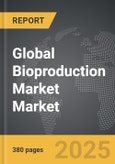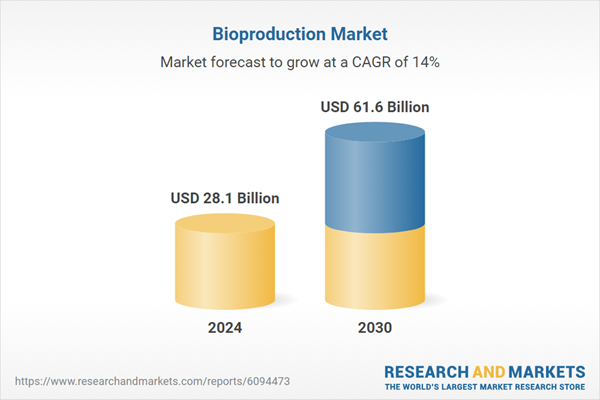Global Bioproduction Market - Key Trends & Drivers Summarized
Why Is Bioproduction Gaining Strategic Importance in the Future of Industrial and Therapeutic Manufacturing?
Bioproduction is rapidly emerging as a critical enabler of modern industrial and biopharmaceutical manufacturing, offering a biologically-driven alternative to traditional synthetic production methods. It refers to the use of living organisms - such as bacteria, yeast, algae, or mammalian cells - to produce a wide range of products, including therapeutic proteins, enzymes, biofuels, vaccines, monoclonal antibodies, and specialty chemicals. As the global demand for biologics, sustainable materials, and eco-friendly manufacturing practices rises, bioproduction is positioned as a highly scalable and sustainable solution that aligns with the needs of the 21st-century economy. In the pharmaceutical sector, bioproduction is indispensable for developing complex biologics that cannot be synthesized chemically, such as insulin, erythropoietin, and various cell and gene therapies. Outside pharma, bioproduction plays a key role in producing biodegradable plastics, plant-based meat alternatives, and bio-based ingredients in the cosmetics, food, and agriculture industries. Its ability to produce high-purity, high-potency substances using renewable feedstocks makes it an attractive alternative to petroleum-based manufacturing. Moreover, bioproduction supports circular economy models, reduces waste, and lowers greenhouse gas emissions, making it a priority in global decarbonization strategies. With its convergence of biology, engineering, and data science, bioproduction is no longer just a research niche - it's an industrial revolution in motion, shaping how we create, consume, and conserve resources across industries.How Are Emerging Technologies and Tools Advancing the Scope and Efficiency of Bioproduction?
Technological innovation is driving the next wave of efficiency, scalability, and customization in bioproduction systems. Key breakthroughs in synthetic biology and metabolic engineering are allowing scientists to program microorganisms with precision, optimizing biosynthetic pathways to maximize yield and minimize by-product formation. CRISPR-Cas and other genome-editing tools are enabling highly targeted genetic modifications, accelerating strain development and enhancing product consistency. Continuous bioprocessing and modular bioproduction platforms are replacing traditional batch processes, offering reduced downtime, higher throughput, and better scalability. Advanced bioreactor designs - including single-use systems, perfusion reactors, and microfluidic platforms - are improving flexibility and enabling real-time adjustments during production. Meanwhile, AI and machine learning algorithms are being employed to predict cell behavior, optimize fermentation parameters, and detect anomalies across upstream and downstream operations. Integration with IoT devices and process analytical technology (PAT) is further enhancing monitoring capabilities, allowing real-time data acquisition and dynamic process control. Furthermore, advancements in downstream processing - such as high-resolution chromatography, membrane filtration, and precipitation technologies - are improving product recovery and purity, especially in high-value therapeutic applications. Cell-free bioproduction systems are also gaining attention for their ability to bypass the limitations of living systems, enabling faster prototyping and on-demand synthesis. As digitalization, automation, and biological sciences continue to converge, the bioproduction industry is evolving into a smart, adaptive, and data-driven ecosystem capable of meeting diverse product demands while ensuring regulatory compliance and process robustness.Which Industries and Geographies Are Driving the Expansion of the Global Bioproduction Ecosystem?
Bioproduction is experiencing accelerated adoption across a broad spectrum of industries and regions, each leveraging biological manufacturing to achieve strategic, regulatory, or sustainability goals. The pharmaceutical and biotechnology sectors remain the largest consumers of bioproduction systems, especially for the production of monoclonal antibodies, recombinant proteins, vaccines, and cell-based therapies. The food and beverage industry is increasingly adopting bioproduction techniques to create alternative proteins, fermented functional ingredients, and bioactive compounds used in supplements and nutraceuticals. In the energy sector, companies are using engineered microbes to convert biomass into renewable fuels like ethanol, biodiesel, and hydrogen. The cosmetics and personal care sectors are also embracing bioproduction to develop eco-friendly fragrances, colorants, and emulsifiers. Regionally, North America leads the market, driven by robust R&D infrastructure, a high concentration of biotech firms, and favorable regulatory frameworks that support innovation. Europe follows closely, with countries like Germany, Switzerland, and the Netherlands focusing on bioeconomy strategies, sustainable chemistry, and green manufacturing. Asia-Pacific is the fastest-growing region, with rapid industrialization, growing investment in life sciences, and supportive government initiatives in countries such as China, India, Japan, and South Korea. Latin America and Africa, while still emerging, are beginning to tap into bioproduction potential by leveraging local biodiversity and agricultural waste streams. In all these regions, public-private partnerships, international research collaborations, and rising consumer demand for sustainable products are fueling the bioproduction market. Whether in therapeutic, industrial, or environmental applications, bioproduction is becoming a global movement that cuts across traditional industry lines and national boundaries.What Is Fueling the Growth in the Global Bioproduction Market?
The growth in the global bioproduction market is driven by a dynamic combination of scientific innovation, commercial demand, regulatory momentum, and global sustainability goals. One of the most significant growth drivers is the escalating demand for biologics and advanced therapies, particularly in the treatment of chronic, genetic, and rare diseases. These therapies often require highly specialized production systems that only bioproduction platforms can offer. Simultaneously, consumer preferences are shifting toward sustainable, ethically produced, and bio-based products in sectors ranging from personal care to agriculture - prompting companies to invest in bioproduction technologies that align with ESG criteria. Governments and regulatory agencies are also playing a pivotal role by supporting bioproduction through funding, tax incentives, and streamlined approval processes for bio-based innovations. As countries pursue climate action targets and circular economy models, bioproduction stands out for its ability to reduce reliance on petrochemicals, minimize waste, and produce energy and materials in a more environmentally friendly way. Additionally, the scalability and flexibility of modern bioproduction systems make them suitable for both large-scale industrial applications and localized, on-demand production - providing resilience and adaptability in volatile supply chain environments. The growth of CDMOs and biofoundries is further accelerating market development by offering outsourced, cost-effective access to high-end bioproduction capabilities. Together, these factors are not only fueling rapid expansion but are also setting the stage for bioproduction to become a foundational technology in a bio-based global economy - reshaping the future of how goods and medicines are produced, consumed, and sustained.Report Scope
The report analyzes the Bioproduction market, presented in terms of market value (US$). The analysis covers the key segments and geographic regions outlined below:- Segments: Product (Biologics & Biosimilars, Vaccines, Cell & Gene Therapies, Nucleic Acid Therapeutics); Application (Rheumatoid Arthritis Application, Hematological Disorders Application, Cancer Application, Diabetes Application, Cardiovascular Diseases Application); End-Use (BioPharmaceuticals Companies End-Use, Contract Manufacturing Organizations End-Use).
- Geographic Regions/Countries: World; United States; Canada; Japan; China; Europe (France; Germany; Italy; United Kingdom; Spain; Russia; and Rest of Europe); Asia-Pacific (Australia; India; South Korea; and Rest of Asia-Pacific); Latin America (Argentina; Brazil; Mexico; and Rest of Latin America); Middle East (Iran; Israel; Saudi Arabia; United Arab Emirates; and Rest of Middle East); and Africa.
Key Insights:
- Market Growth: Understand the significant growth trajectory of the Biologics & Biosimilars segment, which is expected to reach US$32.6 Billion by 2030 with a CAGR of a 16.1%. The Vaccines segment is also set to grow at 10.3% CAGR over the analysis period.
- Regional Analysis: Gain insights into the U.S. market, valued at $7.7 Billion in 2024, and China, forecasted to grow at an impressive 19% CAGR to reach $13.4 Billion by 2030. Discover growth trends in other key regions, including Japan, Canada, Germany, and the Asia-Pacific.
Why You Should Buy This Report:
- Detailed Market Analysis: Access a thorough analysis of the Global Bioproduction Market, covering all major geographic regions and market segments.
- Competitive Insights: Get an overview of the competitive landscape, including the market presence of major players across different geographies.
- Future Trends and Drivers: Understand the key trends and drivers shaping the future of the Global Bioproduction Market.
- Actionable Insights: Benefit from actionable insights that can help you identify new revenue opportunities and make strategic business decisions.
Key Questions Answered:
- How is the Global Bioproduction Market expected to evolve by 2030?
- What are the main drivers and restraints affecting the market?
- Which market segments will grow the most over the forecast period?
- How will market shares for different regions and segments change by 2030?
- Who are the leading players in the market, and what are their prospects?
Report Features:
- Comprehensive Market Data: Independent analysis of annual sales and market forecasts in US$ Million from 2024 to 2030.
- In-Depth Regional Analysis: Detailed insights into key markets, including the U.S., China, Japan, Canada, Europe, Asia-Pacific, Latin America, Middle East, and Africa.
- Company Profiles: Coverage of players such as Acciona Energía, Ameresco Inc., Babcock & Wilcox Enterprises, Inc., BP p.l.c., Cargill, Incorporated and more.
- Complimentary Updates: Receive free report updates for one year to keep you informed of the latest market developments.
Some of the 41 companies featured in this Bioproduction market report include:
- AGC Biologics
- Ajinomoto Bio-Pharma Services
- BioVectra
- Boehringer Ingelheim BioXcellence
- Catalent, Inc.
- Charles River Laboratories
- Cytiva
- Emergent BioSolutions
- FUJIFILM Diosynth Biotechnologies
- Genscript Biotech
- KBI Biopharma
- Lonza Group
- MilliporeSigma (Merck KGaA)
- Novartis
- Pfizer CentreOne
- Resilience (National Resilience, Inc.)
- Rentschler Biopharma SE
- Samsung Biologics
- Sartorius AG
- WuXi Biologics
This edition integrates the latest global trade and economic shifts into comprehensive market analysis. Key updates include:
- Tariff and Trade Impact: Insights into global tariff negotiations across 180+ countries, with analysis of supply chain turbulence, sourcing disruptions, and geographic realignment. Special focus on 2025 as a pivotal year for trade tensions, including updated perspectives on the Trump-era tariffs.
- Adjusted Forecasts and Analytics: Revised global and regional market forecasts through 2030, incorporating tariff effects, economic uncertainty, and structural changes in globalization. Includes historical analysis from 2015 to 2023.
- Strategic Market Dynamics: Evaluation of revised market prospects, regional outlooks, and key economic indicators such as population and urbanization trends.
- Innovation & Technology Trends: Latest developments in product and process innovation, emerging technologies, and key industry drivers shaping the competitive landscape.
- Competitive Intelligence: Updated global market share estimates for 2025, competitive positioning of major players (Strong/Active/Niche/Trivial), and refined focus on leading global brands and core players.
- Expert Insight & Commentary: Strategic analysis from economists, trade experts, and domain specialists to contextualize market shifts and identify emerging opportunities.
Table of Contents
Companies Mentioned (Partial List)
A selection of companies mentioned in this report includes, but is not limited to:
- AGC Biologics
- Ajinomoto Bio-Pharma Services
- BioVectra
- Boehringer Ingelheim BioXcellence
- Catalent, Inc.
- Charles River Laboratories
- Cytiva
- Emergent BioSolutions
- FUJIFILM Diosynth Biotechnologies
- Genscript Biotech
- KBI Biopharma
- Lonza Group
- MilliporeSigma (Merck KGaA)
- Novartis
- Pfizer CentreOne
- Resilience (National Resilience, Inc.)
- Rentschler Biopharma SE
- Samsung Biologics
- Sartorius AG
- WuXi Biologics
Table Information
| Report Attribute | Details |
|---|---|
| No. of Pages | 380 |
| Published | December 2025 |
| Forecast Period | 2024 - 2030 |
| Estimated Market Value ( USD | $ 28.1 Billion |
| Forecasted Market Value ( USD | $ 61.6 Billion |
| Compound Annual Growth Rate | 14.0% |
| Regions Covered | Global |









